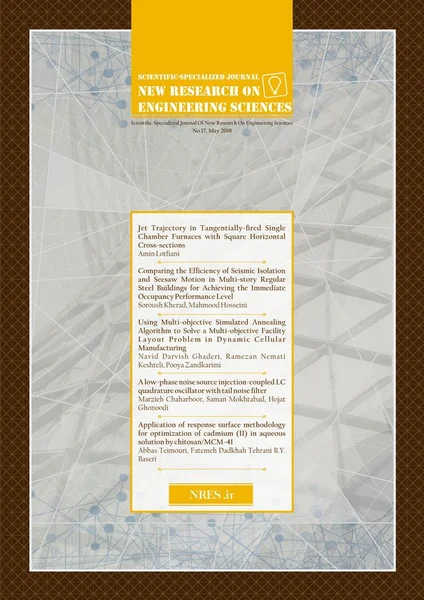-
comparing the efficiency of seismic isolation and seesaw motion in multi-story regular steel buildings for achieving the immediate occupancy performance level
جزئیات بیشتر مقاله- تاریخ ارائه: 1400/08/01
- تاریخ انتشار در تی پی بین: 1400/08/01
- تعداد بازدید: 515
- تعداد پرسش و پاسخ ها: 0
- شماره تماس ژورنال: 02133202487
there are some important buildings which their performance level (pl) should not be lower than immediate occupancy (io) based on the recent seismic design codes. the most common way for achieving this pl is using seismic isolation technique. however this technique has not been acknowledged worldwide so much, particularly in developing countries, mainly due to the high cost and the relatively large required free space around the building which is not usually acceptable for the buildings’ owners. another approach for achieving io pl, proposed in recent years, is using a structural system which can have seesaw motion during an earthquake, and at the same time dissipate a major part of the input energy in its specific dampers or structural fuses, which can be easily replaced after the earthquake. the building with such a system which can be called ‘seesaw building’ needs to have, in addition to the structural fuses, a specific central support and a grid of strong girders at its lowest floor. these additional components add some cost to the costs of the building’s structural system. the aim of this study is comparing the efficiency of common seismic isolation technique with that of the seesaw building, from both seismic performance and construction costs aspects. special attention has been paid to the near-field earthquake to which the common isolation systems are weak. for comparing the seismic behaviors of the two systems, responses of the considered counterpart buildings have been obtained by a series of nonlinear time history analysis by using a set of selected far- and near-field earthquakes. numerical results show that the seesaw building generally behaves better than isolated buildings, with less lateral displacements, and its cost is relatively lower as well. the only shortcoming of the seesaw building is its very little residual displacement at the end of the earthquake, which necessitates some attempts for bringing it back to the original position.
حوزه های تحت پوشش ژورنال
مقالات جدیدترین رویدادها
-
استفاده از تحلیل اهمیت-عملکرد در ارائه الگوی مدیریت خلاقیت سازمانی و ارائه راهکار جهت بهبود
-
بررسی تاثیر ارزش وجوه نقد مازاد بر ساختار سرمایه شرکت های پذیرفته شده در بورس اوراق بهادار تهران
-
بررسی تأثیر سطح افشای ریسک بر قرارداد بدهی شرکت های پذیرفته شده در بورس اوراق بهادار تهران
-
بررسی تأثیر رتبه بندی اعتباری مبتنی بر مدل امتیاز بازار نوظهور بر نقد شوندگی سهام با تأکید بر خصوصی سازی شرکت ها
-
تأثیر آمیخته بازاریابی پوشاک ایرانی بر تصویر ذهنی مشتری پوشاک ایرانی (هاکوپیان)
-
بررسی تحلیلی سیره عقلا به انضمام چگونگی کاشفیت از حکم آن و ثمرات
-
شبیه سازی معتبر رفتار قابهای عرضی در پلهای فولادی خمیده
-
ارزیابی عملکرد لرزه ای میراگرهای تسلیمی t-adas در قاب های فولادی بلند مرتبه تحت تحریکات حوزه نزدیک گسل
-
بهینه یابی سازه های قاب خمشی فولادی با استفاده از الگوریتم ژنتیک تعمیم یافته تحت قیود قابلیت اعتماد
-
تاثیرات سیستم اتوماسیون اداری و بایگانی الکترونیک بر عملکرد سازمان
مقالات جدیدترین ژورنال ها
-
مدیریت و بررسی افسردگی دانش آموزان دختر مقطع متوسطه دوم در دروان کرونا در شهرستان دزفول
-
مدیریت و بررسی خرد سیاسی در اندیشه ی فردوسی در ادب ایران
-
واکاوی و مدیریت توصیفی قلمدان(جاکلیدی)ضریح در موزه آستان قدس رضوی
-
بررسی تاثیر خلاقیت، دانش و انگیزه کارکنان بر پیشنهادات نوآورانه کارکنان ( مورد مطالعه: هتل های 3 و 4 ستاره استان کرمان)
-
بررسی تاثیر کیفیت سیستم های اطلاعاتی بر تصمیم گیری موفق در شرکتهای تولیدی استان اصفهان (مورد مطالعه: مدیران شرکتهای تولیدی استان اصفهان)
-
تاثیر اندوه مقایسه بر سایش اجتماعی با میانجی گری حسادت خاموش
-
بررسی نقش های بیولوژیک و اجتماعی - اقتصادی خرس قهوه ای (ursus arctos syriacus) در توده های جنگلی شمال ایران
-
بررسی ابعاد موفقیت پیاده سازی سیستم های هوش تجاری در شرکت های تولیدی ( مطالعه موردی: شرکت تولیدی سیمان )
-
بررسی و شناخت ماهیت مالیات و اقسام آن
-
the role of environmental graphic in the identification of urban public spaces


سوال خود را در مورد این مقاله مطرح نمایید :